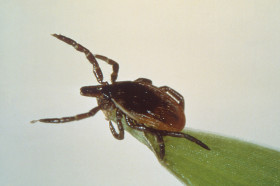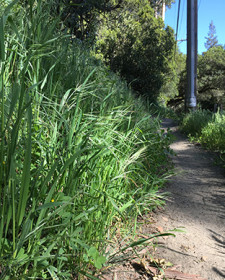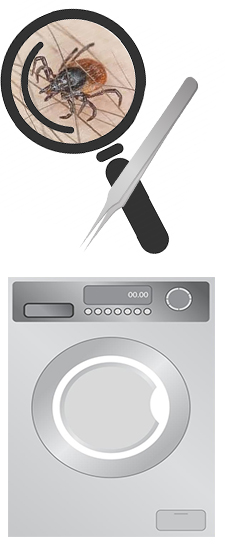May is Lyme Awareness month. And it is indeed time to be aware. Thanks to El Niño, it’s a wetter Spring than we’ve had in several years. That means we have lots of green grass, damp leaf litter, and overgrown trails and paths. It also means the ticks are out. And early spring means nymph season — these nymphs are young ticks, not much bigger than a poppy seed … the kind that are easy to miss with a quick glance.

The good news is that ticks can’t fly, jump, or even run. But they do “quest” — they hang out on leaves, blades of grass, and branches, tiny legs poised to grab onto a warm body passing by. Ticks need to feed in order to progress to the next life stage and perching ready to grab a free ride (and meal!) on an unwitting passerby is how they ensure their survival.
When hiking or biking in the woods, if you keep to the center of the trail and avoid bushwhacking and brushing up against high grasses or other vegetation, your risk of picking up a parasitic passenger is pretty low. Once you leave the trail for a pit stop, however, the risk rises exponentially. Ticks are carried by deer and other small mammals that also like to use the trails so the highest concentration of ticks is often close to trails.

AVOID
The best tactic is certainly to avoid contact with ticks. This time of year the vegetation is fairly dense and you want to be careful of overhanging brush.
On a recent family hike after a discussion about smart tick-sense, it was only minutes and maybe 100-yards down the path before our 12-year-old found a tick perched on the end of a blade of grass just as we had described! Admittedly his eyes are pretty good — the tick itself was smaller than a sesame seed — most of the rest of us might never even have noticed.
Ticks are hitchhiking parasites and they know these trails are high-traffic highways. Keep to the center of the path and avoid going off-trail if you can. Choose your path wisely. Be mindful where you choose to sit or rest.

REPEL
Long pants and sleeves, pants tucked in socks, etc. are all good practice but somewhat unlikely once temperatures warm up… Consider bug repellent.
If you’re comfortable using DEET, you’ll want something that is at least 20 percent. If you prefer to avoid DEET, picardin is a good option. You can also find natural alternatives such as lemon eucalyptus oil which can be found in readily available commercial formulations.
Another option is permethrin, a chemical insecticide used on clothing and other fabrics like picnic blankets, which can keep the ticks at bay while you enjoy the outdoors.

REMOVE
The sooner you remove a tick, the lower your risk of infection. The CDC reports that if a tick is attached to your skin for less than 24 hours, your chance of getting Lyme disease is extremely small; however, other tick-borne diseases may be transmitted more quickly.
- Tick-Check! Ticks are small. You need to look carefully and should use your hands as well as your eyes to feel for the ticks. Get in the habit of checking for ticks every time you are in a potential tick habitat. Check here for more information about how to tick-check. Don’t forget to check your pets too. It is common for Lyme to be transmitted by a tick brought into the home unknowingly by a pet who later curls up next to or crawls into bed with a family member. If you find a tick, don’t panic. See here for more instructions on how to remove a tick once discovered.
- Wash & Dry. Ticks are hard to see, however thoroughly washing in a warm shower or bath will release a tick that has not yet become engorged. In our house, we have adopted a firm no-debate rule (that means no protests from 9-year-olds!) about bathing every night and ideally as soon as they come in from outside to avoid giving the ticks opportunity to travel. You also want to consider your clothing. Notably ticks do not drown but they will bake. General guidelines are to put your clothing into a hot dryer on high heat (before washing). Best practice is up to an hour but studies have found that the higher the heat, the shorter the duration, and as little as 10 minutes can make the difference. Backpacks and other equipment can also be put in the dryer or left outside overnight.
 MONITOR & CONSULT
MONITOR & CONSULT
If you develop a rash or fever within several weeks of removing a tick, see your doctor. Be sure to tell the doctor about your recent tick bite, when the bite occurred, and where you most likely acquired the tick.
It’s tick season. And it’s Lyme awareness month. All good reasons to be smart and be aware. Don’t avoid the outdoors — it’s far too pretty not to get out there and enjoy nature’s beauty — but take the precautions to stay safe.
How do i get an information card necessary to send in ticks, as suggested in recent Parade magazine? I live in central IL and have seen five in the past two weeks . . . .
Please see this page for more information on Bay Area Lyme’s FREE tick testing program (including the details of how to send in your tick(s)). And thank you for being on the watch!!